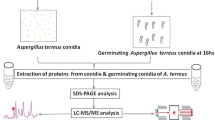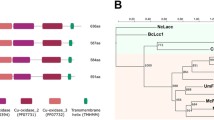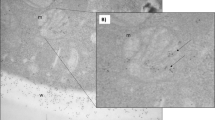Abstract
The opportunistic human pathogen Aspergillus fumigatus produces numerous different natural products. The genetic basis for the biosynthesis of a number of known metabolites has remained unknown. The gene cluster encoding for the biosynthesis of the conidia-bound metabolite trypacidin is of particular interest because of its antiprotozoal activity and possible role in the infection process. Here, we show that the genes encoding the biosynthesis enzymes of trypacidin reside within an orphan gene cluster in A. fumigatus. Genome mining identified tynC as an uncharacterized polyketide synthase with high similarity to known enzymes, whose products are structurally related to trypacidin including endocrocin and fumicycline. Gene deletion of tynC resulted in the complete absence of trypacidin production, which was fully restored when the mutant strain was complemented with the wild-type gene. When confronted with macrophages, the tynC deletion mutant conidia were more frequently phagocytosed than those of the parental wild-type strain. This was also found for phagocytic amoebae of the species Dictyostelium discoideum, which showed increased phagocytosis of ΔtynC conidia. Both macrophages and amoebae were also sensitive to trypacidin. Therefore, our results suggest that the conidium-bound trypacidin could have a protective function against phagocytes both in the environment and during the infection process.




Similar content being viewed by others
References
Aimanianda V, Bayry J, Bozza S, Kniemeyer O, Perruccio K, Elluru SR, Clavaud C, Paris S, Brakhage AA, Kaveri SV, Romani L, Latgé JP (2009) Surface hydrophobin prevents immune recognition of airborne fungal spores. Nature 460(7259):1117–1121
Balan J, Ebringer L, Nemec P (1964) Trypacidin a new antiprotozoal antibiotic. Naturwissenschaften 51(9):227
Balan J, Ebringer L, Nemec P, Kovac S, Dobias J (1963) Antiprotozoal antibiotics. II. Isolation and characterization of trypacidin, a new antibiotic, active against Trypanosoma cruzi and Toxoplasma gondii. J Antibiot (Tokyo) 6:157–160
Baldin C, Valiante V, Krüger T, Schafferer L, Haas H, Kniemeyer O, Brakhage AA (2015) Comparative proteomics of a tor inducible Aspergillus fumigatus mutant reveals involvement of the Tor kinase in iron regulation. Proteomics 15(13):2230–2243
Brakhage AA (2013) Regulation of fungal secondary metabolism. Nat Rev Microbiol 11(1):21–32
Brakhage AA, Langfelder K (2002) Menacing mold: the molecular biology of Aspergillus fumigatus. Annu Rev Microbiol 56:433–455
Brakhage AA (2005) Systemic fungal infections caused by Aspergillus species: epidemiology, infection process and virulence determinants. Curr Drug Targets 6(8):875–886
Bergmann S, Schümann J, Scherlach K, Lange C, Brakhage AA, Hertweck C (2007) Genomics-driven discovery of PKS-NRPS hybrid metabolites from Aspergillus nidulans. Nat Chem Biol 3(4):213–217
Berthier E, Lim FY, Deng Q, Guo CJ, Kontoyiannis DP, Wang CC, Rindy J, Beebe DJ, Huttenlocher A, Keller NP (2013) Low-volume toolbox for the discovery of immunosuppressive fungal secondary metabolites. PLoS Pathog 9(4): e1003289
Cerqueira GC, Arnaud MB, Inglis DO, Skrzypek MS, Binkley G, Simison M, Miyasato SR, Binkley J, Orvis J, Shah P, Wymore F, Sherlock G, Wortman JR (2013) The Aspergillus genome database (AspGD): multispecies curation and incorporation of RNA-Seq data to improve structural gene annotations. Nucl Acids Res 42(Database issue):D705–D710
Chai LY, Vonk AG, Kullberg BJ, Verweij PE, Verschueren I, van der Meer JW, Joosten LA, Latgé JP, Netea MG (2011) Aspergillus fumigatus cell wall components differentially modulate host TLR2 and TLR4 responses. Microbes Infect 13(2):151–159
Chiang YM, Szewczyk E, Davidson AD, Entwistle R, Keller NP, Wang CC, Oakley BR (2010) Characterization of the Aspergillus nidulans monodictyphenone gene cluster. Appl Environ Microbiol 76(7):2067–2074
Chooi YH, Fang J, Liu H, Filler SG, Wang P, Tang Y (2013) Genome mining of a prenylated and immunosuppressive polyketide from pathogenic fungi. Org Lett 15(4):780–783
Coyle CM, Panaccione DG (2005) An ergot alkaloid biosynthesis gene and clustered hypothetical genes from Aspergillus fumigatus. Appl Environ Microbiol 71(6):3112–3118
Ebringer L, Catar G, Balan J, Nemec P, Kov’ac S (1963) Antiprotozoal antibiotics. III Preliminary Report on the Effect of Trypacidin on Experimental Toxoplasmosis J Antibiot (Tokyo) 16:161–162
Ebringer L, Balan J, Nemec P (1964) Incidence of antiprotozoal substances in Aspergillaceae. J Protozool 11(2):153–156
Fischer G, Müller T, Ostrowski R, Dott W (1999) Mycotoxins of Aspergillus fumigatus in pure culture and in native bioaerosols from compost facilities. Chemosphere 38(8):1745–1755
Frisvad JC, Rank C, Nielsen KF, Larsen TO (2009) Metabolomics of Aspergillus fumigatus. Med Mycol 47(Suppl 1):S72–S79
Gauthier T, Wang X, Sifuentes Dos Santos J, Fysikopoulos A, Tadrist S, Canlet C, Artigot MP, Loiseau N, Oswald IP, Puel O (2012) Trypacidin, a spore-borne toxin from Aspergillus fumigatus, is cytotoxic to lung cells. PLoS One 7(2):e29906
Gibson DG, Young L, Chuang RY, Venter JC, Hutchison III CA, Smith HO (2009) Enzymatic assembly of DNA molecules up to several hundred kilobases. Nat Methods 6(5):343–345
Guo CJ, Wang CC (2014) Recent advances in genome mining of secondary metabolites in Aspergillus terreus. Front Microbiol 23(717):1–13
Heinekamp T, Schmidt H, Lapp K, Pähtz V, Shopova I, Köster-Eiserfunke N, Krüger T, Kniemeyer O, Brakhage AA (2015) Interference of Aspergillus fumigatus with the immune response. Semin Immunpathol 37(2):141–152
Hillmann F, Novohradská S, Mattern DJ, Forberger T, Heinekamp T, Westermann M, Winckler T, Brakhage AA (2015) Virulence determinants of the human pathogenic fungus Aspergillus fumigatus protect against soil amoeba predation. Environ Microbiol doi:. doi:10.1111/1462-2920.12808
Ibrahim-Granet O, Philippe B, Boleti H, Boisvieux-Ulrich E, Grenet D, Stern M, Latgé JP (2003) Phagocytosis and intracellular fate of Aspergillus fumigatus conidia in alveolar macrophages. Infect Immun 71(2):891–903
Jahn B, Koch A, Schmidt A, Wanner G, Gehringer H, Bhakdi S, Brakhage AA (1997) Isolation and characterization of a pigmentless-conidium mutant of Aspergillus fumigatus with altered conidial surface and reduced virulence. Infect Immun 65(12):5110–5117
Kraibooj K, Park HR, Dahse HM, Skerka C, Voigt K, Figge MT (2014) Virulent strain of Lichtheimia corymbifera shows increased phagocytosis by macrophages as revealed by automated microscopy image analysis. Mycoses Suppl 3:56–66
König CC, Scherlach K, Schroeckh V, Horn F, Nietzsche S, Brakhage AA, Hertweck C (2013) Bacterium induces cryptic meroterpenoid pathway in the pathogenic fungus Aspergillus fumigatus. Chembiochem 14(8):938–942
Kurup VP (1984) Interaction of Aspergillus fumigatus spores and pulmonary alveolar macrophages of rabbits. Immunobiology 166(1):53–61
Lim FY, Hou Y, Chen Y, Oh JH, Lee I, Bugni TS, Keller NP (2012) Genome based cluster deletion reveals an endocrocin biosynthetic pathway in Aspergillus fumigatus. Appl Environ Microbiol 78(12):4117–4125
Luther K, Torosantucci A, Brakhage AA, Heesemann J, Ebel F (2007) Phagocytosis of Aspergillus fumigatus conidia by murine macrophages involves recognition by the dectin-1 β-glucan receptor and toll-like receptor 2. Cell Microbiol 9(2):368–381
Maerker C, Rohde M, Brakhage AA, Brock M (2005) Methylcitrate synthase from Aspergillus fumigatus. Propionyl-CoA affects polyketide synthesis, growth and morphology of conidia. FEBS J 272(14):3615–3630
Marchler-Bauer A, Panchenko AR, Shoemaker BA, Thiessen PA, Geer LY, Bryant SH (2002) CDD: a database of conserved domain alignments with links to domain three-dimensional structure. Nucl Acids Res 30(1):281–283
Mech F, Thywissen A, Guthke R, Brakhage AA, Figge MT (2011) Automated image analysis of the host-pathogen interaction between phagocytes and Aspergillus fumigatus. PLoS One 6(5):e19591
Mech F, Wilson D, Lehnert T, Hube B, Figge MT (2014) Epithelial invasion outcompetes hypha development during Candida albicans infection as revealed by an image-based systems biology approach. Cytometry A 85(2):126–139
Meier A, Kirschning CJ, Nikolaus T, Wagner H, Heesemann J, Ebel F (2003) Toll-like receptor (TLR) 2 and TLR4 are essential for Aspergillus-induced activation of murine macrophages. Cell Microbiol 5(8):561–570
Nemec P, Balan J, Ebringer L (1963) Antiprotozoal antibiotics. I J Antibiot (Tokyo) 16:155–156
Netea MG, Warris A, Van der Meer JW, Fenton MJ, Verver-Janssen TJ, Jacobs LE, Andresen T, Verweij PE, Kullberg BJ (2003) Aspergillus fumigatus evades immune recognition during germination through loss of toll-like receptor-4-mediated signal transduction. J Infect Dis 188(2):320–326
Nielsen ML, Nielsen JB, Rank C, Klejnstrup ML, Holm DK, Brogaard KH, Hansen BG, Frisvad JC, Larsen TO, Mortensen UH (2011) A genome-wide polyketide synthase deletion library uncovers novel genetic links to polyketides and meroterpenoids in Aspergillus nidulans. F E M S Microbiol Lett 321(2):157–166
Nielsen MT, Nielsen JB, Anyaogu DC, Holm DK, Nielsen KF, Larsen TO, Mortensen UH (2013) Heterologous reconstitution of the intact geodin gene cluster in Aspergillus nidulans through a simple and versatile PCR based approach. PLoS One 8(8):e72871
Parker GF, Jenner PC (1968) Distribution of trypacidin in cultures of Aspergillus fumigatus. Appl Microbiol 16(8):1251–1252
Philippe B, Ibrahim-Granet O, Prévost MC, Gougerot-Pocidalo MA, Sanchez Perez M, Van der Meeren A, Latgé JP (2003) Killing of Aspergillus fumigatus by alveolar macrophages is mediated by reactive oxidant intermediates. Infect Immun 71(6):3034–3042
Scharf DH, Heinekamp T, Remme N, Hortschansky P, Brakhage AA, Hertweck C (2012) Biosynthesis and function of gliotoxin in Aspergillus fumigatus. Appl Microbiol Biotechnol 93(2):467–472
Scharf DH, Heinekamp T, Brakhage AA (2014a) Human and plant fungal pathogens: the role of secondary metabolites. PLoS Pathog 10(1):e1003859
Scharf DH, Habel A, Heinekamp T, Brakhage AA, Hertweck C (2014b) Opposed effects of enzymatic gliotoxin N- and S-methylations. J Am Chem Soc 136(33):11674–11679
Steele C, Rapaka RR, Metz A, Pop SM, Williams DL, Gordon S, Kolls JK, Brown GD (2005) The β-glucan receptor dectin-1 recognizes specific morphologies of Aspergillus fumigatus. PLoS Pathog 1(4):e42
Szewczyk E, Nayak T, Oakley CE, Edgerton H, Xiong Y, Taheri-Talesh N, Osmani SA, Oakley BR (2006) Fusion PCR and gene targeting in Aspergillus nidulans. Nat Protoc 1(6):3111–3120
Szewczyk E, Chiang YM, Oakley CE, Davidson AD, Wang CCC, Oakley BR (2008) Identification and characterization of the asperthecin gene cluster of Aspergillus nidulans. Appl Environ Microbiol 74(24):7607–7612
Tae H, Sohng JK, Park K (2009) MapsiDB: an integrated web database for type I polyketide synthases. Bioprocess Biosyst Eng 32(6):723–727
Then Bergh KT, Litzka O, Brakhage AA (1996) Identification of a major cis-acting DNA element controlling the bidirectionally transcribed penicillin biosynthesis genes acvA (pcbAB) and ipnA (pcbC) of Aspergillus nidulans. J Bacteriol 178(13):3908–3916
Thywißen A, Heinekamp T, Dahse HM, Schmaler-Ripcke J, Nietzsche S, Zipfel PF, Brakhage AA (2011) Conidial dihydroxynaphthalene melanin of the human pathogenic fungus Aspergillus fumigatus interferes with the host endocytosis pathway. Front Microbiol 2:96
Turner WB (1965) The production of trypacidin and monomethylsulochrin by Aspergillus fumigatus. J Chem Soc 6658-6659
Unkles SE, Valiante V, Mattern DJ, Brakhage AA (2014) Synthetic biology tools for bioprospecting of natural products in eukaryotes. Chem Biol 21(4):502–508
Van Waeyenberghe L, Baré J, Pasmans F, Claeys M, Bert W, Haesebrouck F, Houf K, Martel A (2013) Interaction of Aspergillus fumigatus conidia with Acanthamoeba castellanii parallels macrophage-fungus interactions. Environ Microbiol Rep 5(6):819–824
Yaegashi J, Oakley BR, Wang CC (2014) Recent advances in genome mining of secondary metabolite biosynthetic gene clusters and the development of heterologous expression systems in Aspergillus nidulans. J Ind Microbiol Biotechnol 41(2):433–442
Acknowledgments
We thank Carmen Schult and Eva-Maria Neumann for excellent technical assistance, Andrea Perner for HRMS measurements, and Franziska Schmidt for macrophage cultivations. We also thank Thorsten Heinekamp and Maria Straßburger for insightful conversations. This work was supported by the Deutsche Forschungsgemeinschaft (DFG)-funded Graduate School of Excellence, Jena School for Microbial Communication, and the DFG-funded collaborative research center / Transregio (SFB/TR) 124 Human-pathogenic fungi and their human host–networks of interaction FungiNet (project A1 to AB and project B4 to MTF).
Conflict of interest
The authors declare that they have no conflict of interest.
Author information
Authors and Affiliations
Corresponding author
Electronic supplementary material
Below is the link to the electronic supplementary material.
ESM 1
(PDF 579 kb)
Rights and permissions
About this article
Cite this article
Mattern, D.J., Schoeler, H., Weber, J. et al. Identification of the antiphagocytic trypacidin gene cluster in the human-pathogenic fungus Aspergillus fumigatus . Appl Microbiol Biotechnol 99, 10151–10161 (2015). https://doi.org/10.1007/s00253-015-6898-1
Received:
Revised:
Accepted:
Published:
Issue Date:
DOI: https://doi.org/10.1007/s00253-015-6898-1




